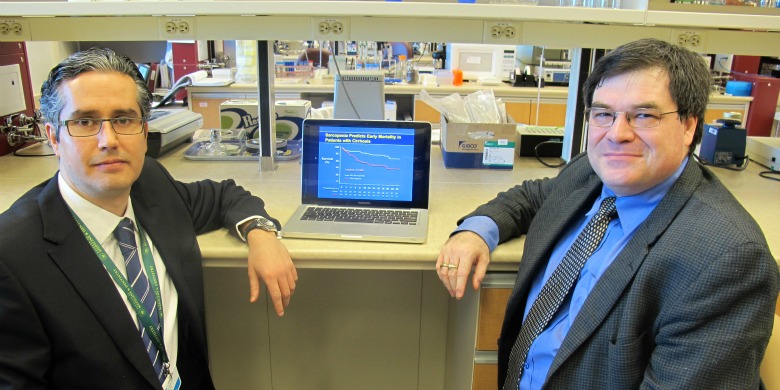
U of A medical researchers Aldo J. Montano-Loza (left) and Michael Sawyer.
(Edmonton) Medical researchers at the University of Alberta have discovered that patients with a liver-scarring condition called cirrhosis who also have low muscle mass are more likely to die waiting for a liver transplant.
The patients had been placed at a lower spot on the transplant list because they had a higher-functioning liver and were seemingly less sick than others with the same condition based on scoring systems physicians commonly use today.
"Patients with cirrhosis who have low muscle mass are actually more sick than what current scoring systems are telling us and many of them die while waiting on the liver transplant lists," says principal investigator Michael Sawyer, a researcher in the Department of Oncology with the Faculty of Medicine & Dentistry and a practising oncologist at the Cross Cancer Institute.
Sawyer says the results demonstrate physicians need to consider muscle mass in conjunction with other factors when assessing where on the transplant list to place a patient with cirrhosis. Muscle mass can be seen through CT images commonly ordered for cirrhosis patients.
Sawyer and his team reviewed the medical records of 112 patients with cirrhosis who were awaiting liver transplants at the University of Alberta Hospital and discovered 40 per cent of them had muscle-wasting or low muscle mass. Cirrhosis is the final phase of chronic liver diseases, characterized by scarring of the liver and poor liver function. Patients with low muscle mass lived for about 19 months if they didn't get a transplant, while those with normal muscle mass lived for about 34 months without a liver transplant.
"Those in the medical field have been looking for better methods to assess patients with cirrhosis and this may be that missing piece to the puzzle," Sawyer says. "If we can combine this measure of muscle mass with the current scoring system, it will provide a better way of predicting survival rates of patients awaiting liver transplants."
Sawyer hopes this additional assessment tool will be incorporated into medical practice within the next three to four years.
The review by the U of A team was published in the American peer-reviewed journal Clinical Gastroenterology and Hepatology. An editorial about the research was also published in the February issue and noted the researchers provided a "promising tool" and "tantalizing evidence."
The Alberta Cancer Foundation funded the research. CEO Myka Osinchuk says the findings will improve care for patients. "Dr. Sawyer's research is an example of how new knowledge and the understanding of disease is vital to advancing clinical care," says Osinchuk.
"It is gratifying to know that Dr. Sawyer and his team have taken this research to another, unexpected level and are challenging the medical field to a new way of thinking."
Sawyer and one of his teammates, Aldo J. Montano-Loza, who works in the Division of Gastroenterology in the Faculty of Medicine & Dentistry, have received further funding from the American College of Gastroenterology to continue their work.
The study originally looked at the incidence of low muscle mass in both cirrhosis patients and patients with liver cancer. The liver cancer findings are yet to be published.
The team recently presented its findings at research conferences in both Canada and Europe.